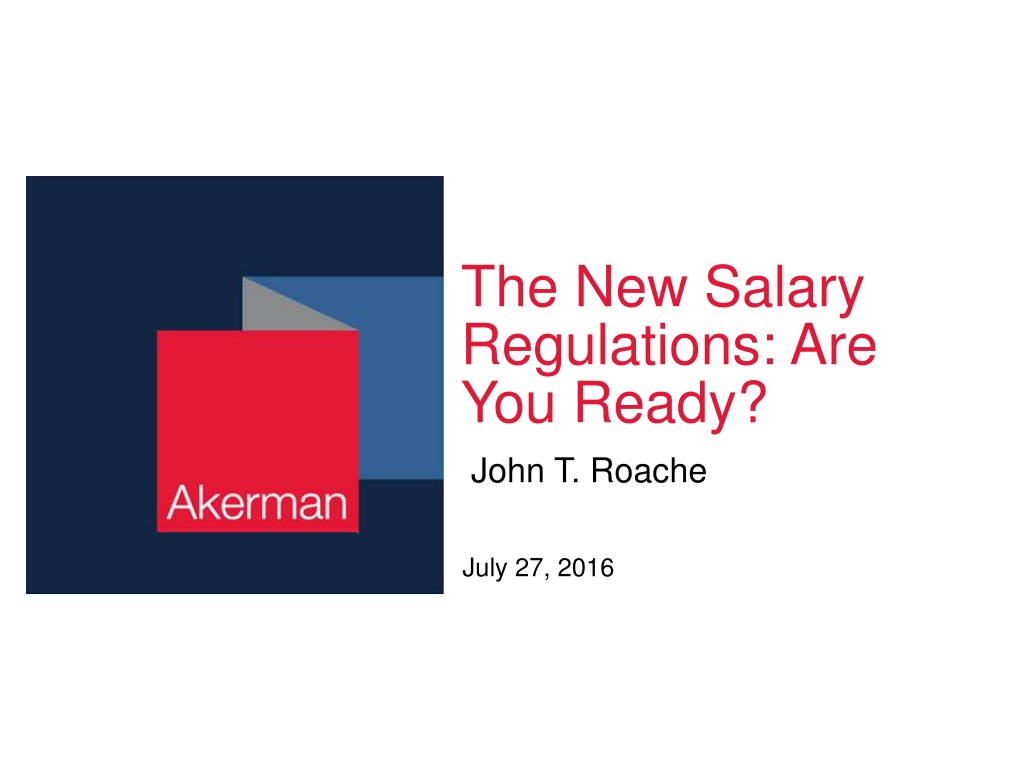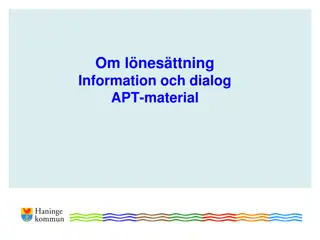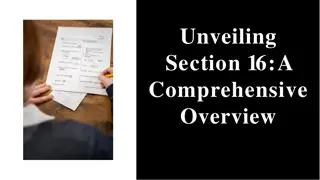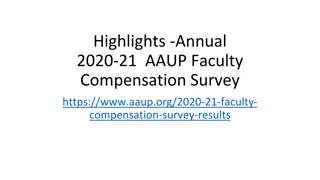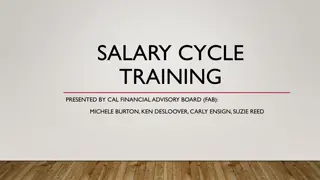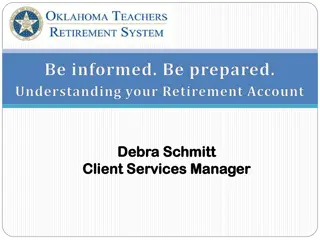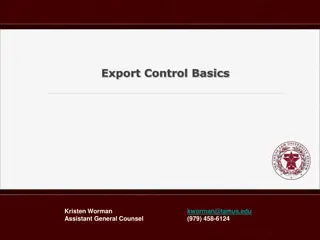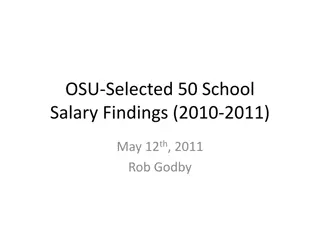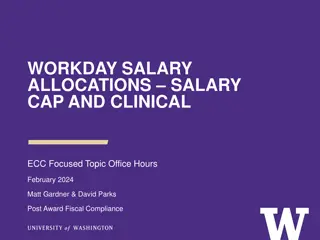Understanding the New Salary Regulations and Compliance Guidelines
Explore the key changes in the latest salary regulations affecting executive, administrative, and professional exemptions. Learn about the updated salary levels, the importance of meeting minimum requirements, and how incentive compensation can be used for compliance. Understand that job titles alone do not determine exempt status.
- Salary regulations
- Compliance guidelines
- Exemption criteria
- Incentive compensation
- Job classifications
Download Presentation

Please find below an Image/Link to download the presentation.
The content on the website is provided AS IS for your information and personal use only. It may not be sold, licensed, or shared on other websites without obtaining consent from the author. Download presentation by click this link. If you encounter any issues during the download, it is possible that the publisher has removed the file from their server.
E N D
Presentation Transcript
The New Salary Regulations: Are You Ready? John T. Roache July 27, 2016
Are You Ready? DOL s Final Rule updates salary level for executive, administrative and professional ( white collar ) exemptions Key changes Impact of Final Rule Options for compliance with the Final Rule Akerman | 2
White Collar Exemption Salary Basis Test How paid Predetermined and fixed salary not subject to reductions Salary Level Test How much paid Meet minimum as specified by regulations Duties Test Primary duties (executive, administrative, or professional) Akerman | 3
Reminder PAYMENT ON SALARY BASIS ALONE DOES NOT MAKE AN EMPLOYEE EXEMPT JOB TITLES NEVER DETERMINE EXEMPT STATUS SALARY BASIS, SALARY LEVEL PLUS DUTIES = EXEMPT Akerman | 4
Key Changes Imposed by the Final Rule
Change: Increase in Standard Salary Level From $23,660 ($455 per week) to $47,476 per year ($913 per week) Represents 40thpercentile in lowest-wage Census region (currently the South) Akerman | 6
Change: Increase in HCE Salary Threshold Highly Compensated Employees From $100,000 ($1,923.07 per week) to $134,004 per year ($2,577 per week) 90thpercentile for FT employees nationwide Akerman | 7
Change: Use of Incentive Compensation up to 10% Employers can use nondiscretionary bonuses and incentive payments (including commissions) to satisfy up to 10 percent of the standard salary level Must be made at least on quarterly basis Catch-up payment permitted at end of each quarter, but MUST be paid within next pay period Cannot use bonuses and incentive payments to meet standard for HCE Akerman | 8
Change: Automatic Updates Salary threshold level automatically updated every three years Next increase: January 1, 2020 DOL estimates increase: $51,168 for standard salary level and $147,524 for HCE To be maintained at 40thpercentile of FT salaried workers in lowest-wage Census region DOL plan on announcing increase 150 days in advance of effective date (target early August 2019) Akerman | 9
Final Rule Effective Date December 1, 2016 4.2 million workers expected to gain new overtime protections or get a raise Akerman | 10
Why the Salary Increase? DOL s views Last updated 2004 Put more money into the pockets of many middle class employees or give them more free time Prevent future erosion of overtime protections and ensure greater predictability Strengthen overtime protections for currently exempt employees Provide greater clarity for workers and employers - easier to differentiate between exempt/non-exempt employees Akerman | 11
Why the Salary Increase? DOL s views Increase employment by spreading work Current salary level below poverty level for family of four Improve work-life balance and employees health Lead to less litigation Akerman | 12
Important Notes to Remember about the Final Rule
DOLs Final Rule . . . Does NOT change Duties Test Executive Administrative Professional Akerman | 14
White Collar Exemptions Executive Exemption to qualify under NEW Rule, must meet all of the following: Compensated at no less than $913/week ($47,476/year); Primary duty of managing the enterprise, or managing a customarily recognized department or subdivision; Must customarily and regularly direct the work of at least two or more other full-time employees or their equivalent; and Must have authority to hire or fire other employees, or employee s suggestions and recommendations as to hiring, firing, advancement, promotion or any other change of status of other employees must be given particular weight Akerman | 15
White Collar Exemptions Administrative Exemption to qualify, must meet all of the following: Compensated at no less than $913/week ($47,476/year); Primary duty must be the performance of office or non-manual work directly related to the management or general business operations of the employer or the employer s customers; and Primary duty includes the exercise of discretion and independent judgment with respect to matters of significance Akerman | 16
White Collar Exemptions Professional Exemption (two types) Learned Professionals to qualify, must meet all of the following: Compensated at no less than $913/week ($47,476/year); Primary duty must be the performance of work requiring advanced knowledge (work that is predominantly intellectual in character including work requiring consistent exercise of discretion and judgment); Advanced knowledge must be in a field of science or learning; and Advanced knowledge must be customarily acquired by a prolonged course of specialized intellectual instruction Akerman | 17
White Collar Exemptions Professional Exemption (two types) Creative Professionals to qualify, must meet all of the following: Compensated at no less than $913/week ($47,476/year); and Primary duty must be the performance of work requiring invention, imagination, originality or talent in a recognized field of artistic or creative endeavor Akerman | 18
Impact of the Final Rule on Certain Sectors
FLSA Coverage and Non-Profits Neither FLSA nor new Rule provide an exemption from OT requirements for non-profit organizations Ways covered by FLSA: Enterprise Coverage Annual revenue $500,000 or more Non-profit organizations with commercial activity for business purpose with annual sales of $500,000 or more (i.e., gift shop or service for a fee) Income from contributions, membership fees, dues and donations NOT counted towards $500,000 threshold Akerman | 20
FLSA Coverage and Non-Profits Ways covered by FLSA: Individual Coverage Regularly engages in interstate commerce or production of goods in interstate commerce Examples of individuals covered: Types letters to send to other states Ships material to another state Transports persons or property to another state Processes credit card transactions Akerman | 21
Mistakes Are Costly Exposure for non-compliance Overtime wages for past 2 years (3 years if willful) An equal amount as liquidated damages Interest Attorneys fees and costs Claims may be brought as a collective action for all similarly situated employees State laws may provide protection even if the FLSA does not apply to the employer Akerman | 22
Options for Compliance to the Final Rule
Raise salaries Raise salaries of employees who meet duties tests, earn close to new salary level, and regularly work overtime Akerman | 24
Reclassify as Non-Exempt #1 Reclassify as non-exempt, adjust base pay, pay the salary for first 40 hours per week, and then overtime for any hours over 40 Adjust amount of employee s earnings to reallocate it between regular rate of pay and overtime compensation #2 Reclassify as non-exempt and use the Fluctuating Workweek Method #3 Reclassify as non-exempt, pay on an hourly basis, and pay overtime at 1.5 times the regular rate Akerman | 25
Reorganize and Adjust to Avoid Overtime Reduce hours Reorganize workload distribution Adjust employee schedules Hire additional employees Akerman | 26
Conduct Audit NOW Use DOL s Final Rule as reason to conduct audit now - ensure all employees are properly classified Akerman | 27
Additional Reminders No requirement to automatically convert employees to hourly pay where they do not meet the new salary threshold. Employees may be categorized as salaried, non-exempt and paid overtime based on their salary. Employers can use any method for recording hours, as long as employer s system is complete and accurate. Best practices would include a system pursuant to which employees verify the hours worked on a weekly basis. Akerman | 28
Contact John T. Roache, Partner Labor & Employment Attorney Akerman LLP (Chicago, IL Office) 71 S. Wacker Drive 46thFloor Chicago, IL 60606 312.634.5737 john.roache@akerman.com Subscribe to Akerman s HR Defense Blog! (www.hrdefenseblog.com) Akerman | 29
Akerman LLP Locations Akerman | 23
